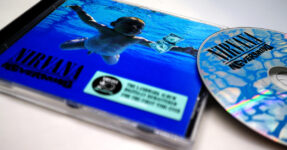Nirvana Baby Sues the Band for Child Pornography

The naked baby who appeared on the cover of Nirvana’s highly successful Nevermind album is now all grown up and suing the band.
Spencer Elden, now 30, has filed a lawsuit seeking $US150,000 ($AUD206,000) in damages against Kurt Cobain’s estate and other band members, as well as the photographer, art director and several record companies (some of which are now defunct) that were involved in the production, release and/or distribution of the album over the past three decades.
The lawsuit alleges that Mr Eldon was unable to consent to having his image used for the iconic 1991 album, and that the publication of the picture violated federal child pornography laws and sexually exploited him.
It’s been reported that his parents were paid $US200 ($AUD276) for the photo, which Mr Elden’s father is said to have authorised his photographer friend to take.
Mr Eldon claims he has suffered “lifelong damage” by having his naked body on the famous cover.
Federal proceedings
The federal lawsuit alleges, “the band, photographer and record labels “intentionally marketed Spencer’s child pornography and leveraged the shocking nature of his image to promote themselves and their music at his expense.”
Mr Eldon, has recreated the cover fully clothed over the years, most recently in 2016 to mark its 25th Anniversary. At the time he expressed deeply mixed feelings, telling media “the anniversary means something to me. It’s strange that I did this for five minutes when I was four months old and it became this really iconic image.”
In an interview with Australian GQ Magazine he said he was “pissed off” about it. “I’ve been going through it my whole life. But recently I’ve been thinking, ‘What if I wasn’t OK with my freaking penis being shown to everybody?’ I didn’t really have a choice.”
In yet another interview, Mr Eldon said: “It’s hard not to get upset when you hear how much money was involved… [When] I go to a baseball game and think about it: ‘Man, everybody at this baseball game has probably seen my little baby penis,’ I feel like I got part of my human rights revoked.”
Seeking damages, injunction and legal costs
The suit is seeking damages, legal fees and an injunction to stop the band from profiting from the hit album, as well as a trial by jury.
According to documents filed in the federal suit, Mr Eldon has suffered permanent harm as a result of the image. This includes, but is not limited to:
“extreme and permanent emotional distress with physical manifestations, interference with his normal development and educational progress, lifelong loss of income earning capacity, loss of past and future wages, past and future expenses for medical and psychological treatment, loss of enjoyment of life, and other losses to be described and proven at trial of this matter.”
The album cover shows infant Spencer Eldon underwater in a swimming pool with his genitalia exposed, reaching forward towards a dollar bill on a fishhook.
The image has long been understood to be making a statement about capitalism.
‘Offensive’ to real victims
Legal experts in the US say that non-sexualised naked photos of infants are generally not considered child pornography under the law.
However, Mr Eldon’s legal team argue that it crosses the line into child pornography, asserting that the inclusion of currency in the shot makes the baby appear “like a sex worker.”
However, many who work with childhood sexual assault survivors have called the lawsuit “offensive” and “frivolous” for those who have truly suffered at the hands of child sexual abusers.
All are in agreement though that the real question the jury will have to consider is whether the image fits the definition of child pornography in the US.
Child abuse material laws in New South Wales
Section 91FB of the Crimes Act 1900 (NSW) defines “child abuse material” as that which depicts or describes, in a way that reasonable person would regard as being, in all the circumstances, offensive, such as:
- A person who is, appears to be or is implied to be, a child as a victim of torture, cruelty or physical abuse,
- A person who is, appears to be or is implied to be, a child engaged in or apparently engaged in a sexual pose or sexual activity (whether or not in the presence of other persons),
- A person who is, appears to be or is implied to be, a child in the presence of another,person who is engaged or apparently engaged in a sexual pose or sexual activity, or
- The private parts of a person who is, appears to be or is implied to be, a child.
In determining whether reasonable persons would regard particular material as being, in all the circumstances, offensive, the following factors are taken into account:
- The standards of morality, decency and propriety generally accepted by reasonable adults,
- The literary, artistic or educational merit (if any) of the material,
- The journalistic merit (if any) of the material, being the merit of the material as a record or report of a matter of public interest, and
- The general character of the material (including whether it is of a medical, legal or scientific character).
Private parts are a person’s genital area or anal area, or the breasts of a female person.
A ‘child’ is a person under the age of 16 years.
The offence of producing, disseminating or accessing child abuse material
Disseminating, possessing or producing child abuse material is an offence under section 91H of the Crimes Act 1900 (NSW) which carries a maximum penalty of 10 years in prison.
To establish the offence, the prosecution must prove beyond reasonable doubt that:
- You possessed, disseminated or produced material, and
- The material was child abuse material.
‘Possession’ includes physical custody or control of material or data.
‘Dissemination’ includes:
- sending, supplying, exhibiting, transmitting or communicating to another,
- making available for access by another, and
- entering an agreement or arrangement to do so.
‘Production’ includes:
- filming, photographing, printing or otherwise making,
- altering or manipulating, and
- entering an agreement or arrangement to do so.
Child abuse material charges cover: Filming, photographing, printing or otherwise making child abuse material, or altering or manipulating any image for the purpose of making child abuse material, or initiating or entering into any agreement or arrangement to do so.







